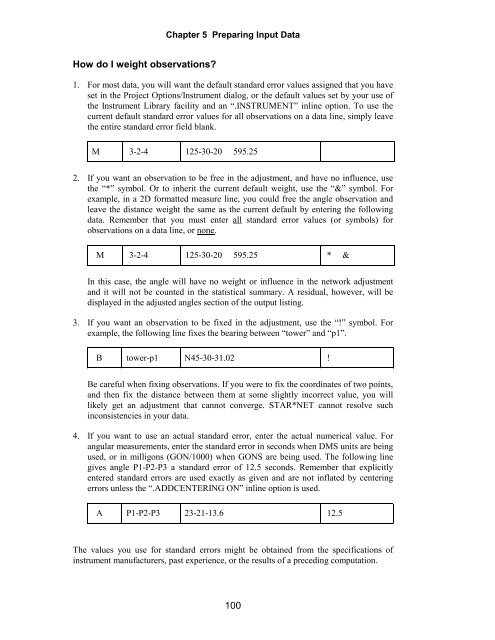STAR*NET V6 - Circe
STAR*NET V6 - Circe
STAR*NET V6 - Circe
You also want an ePaper? Increase the reach of your titles
YUMPU automatically turns print PDFs into web optimized ePapers that Google loves.
How do I weight observations?<br />
Chapter 5 Preparing Input Data<br />
1. For most data, you will want the default standard error values assigned that you have<br />
set in the Project Options/Instrument dialog, or the default values set by your use of<br />
the Instrument Library facility and an “.INSTRUMENT” inline option. To use the<br />
current default standard error values for all observations on a data line, simply leave<br />
the entire standard error field blank.<br />
M 3-2-4 125-30-20 595.25<br />
2. If you want an observation to be free in the adjustment, and have no influence, use<br />
the “*” symbol. Or to inherit the current default weight, use the “&” symbol. For<br />
example, in a 2D formatted measure line, you could free the angle observation and<br />
leave the distance weight the same as the current default by entering the following<br />
data. Remember that you must enter all standard error values (or symbols) for<br />
observations on a data line, or none.<br />
M 3-2-4 125-30-20 595.25 * &<br />
In this case, the angle will have no weight or influence in the network adjustment<br />
and it will not be counted in the statistical summary. A residual, however, will be<br />
displayed in the adjusted angles section of the output listing.<br />
3. If you want an observation to be fixed in the adjustment, use the “!” symbol. For<br />
example, the following line fixes the bearing between “tower” and “p1”.<br />
B tower-p1 N45-30-31.02 !<br />
Be careful when fixing observations. If you were to fix the coordinates of two points,<br />
and then fix the distance between them at some slightly incorrect value, you will<br />
likely get an adjustment that cannot converge. <strong>STAR*NET</strong> cannot resolve such<br />
inconsistencies in your data.<br />
4. If you want to use an actual standard error, enter the actual numerical value. For<br />
angular measurements, enter the standard error in seconds when DMS units are being<br />
used, or in milligons (GON/1000) when GONS are being used. The following line<br />
gives angle P1-P2-P3 a standard error of 12.5 seconds. Remember that explicitly<br />
entered standard errors are used exactly as given and are not inflated by centering<br />
errors unless the “.ADDCENTERING ON” inline option is used.<br />
A P1-P2-P3 23-21-13.6 12.5<br />
The values you use for standard errors might be obtained from the specifications of<br />
instrument manufacturers, past experience, or the results of a preceding computation.<br />
100

















